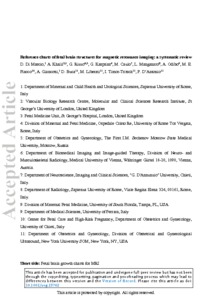Di Mascio, D;
Khalil, A;
Rizzo, G;
Kasprian, G;
Caulo, M;
Manganaro, L;
Odibo, A;
Flacco, ME;
Giancotti, A;
Buca, D;
et al.
Di Mascio, D; Khalil, A; Rizzo, G; Kasprian, G; Caulo, M; Manganaro, L; Odibo, A; Flacco, ME; Giancotti, A; Buca, D; Liberati, M; Timor-Tritsch, I; D'Antonio, F
(2022)
Reference ranges for fetal brain structures using magnetic resonance imaging: systematic review.
Ultrasound Obstet Gynecol, 59 (3).
pp. 296-303.
ISSN 1469-0705
https://doi.org/10.1002/uog.23762
SGUL Authors: Khalil, Asma
![[img]](https://openaccess.sgul.ac.uk/113596/1.hassmallThumbnailVersion/uog.23762.pdf)  Preview |
|
PDF
Accepted Version
Available under License ["licenses_description_publisher" not defined].
Download (1MB)
| Preview
|
Abstract
Objective
To evaluate the methodology of studies reporting reference ranges for fetal brain structures on magnetic resonance imaging (MRI).
Methods
MEDLINE, EMBASE, CINAHL and the Web of Science databases were searched electronically up to 31 December 2020 to identify studies investigating biometry and growth of the fetal brain and reporting reference ranges for brain structures using MRI. The primary aim was to evaluate the methodology of these studies. A list of 26 quality criteria divided into three domains, including ‘study design’, ‘statistical and reporting methods’ and ‘specific aspects relevant to MRI’, was developed and applied to evaluate the methodological appropriateness of each of the included studies. The overall quality score of a study, ranging between 0 and 26, was defined as the sum of scores awarded for each quality criterion and expressed as a percentage (the lower the percentage, the higher the risk of bias).
Results
Fifteen studies were included in this systematic review. The overall mean quality score of the studies evaluated was 48.7%. When focusing on each domain, the mean quality score was 42.0% for ‘study design’, 59.4% for ‘statistical and reporting methods’ and 33.3% for ‘specific aspects relevant to MRI’. For the ‘study design’ domain, sample size calculation and consecutive enrolment of women were the items found to be at the highest risk of bias. For the ‘statistical and reporting methods’ domain, the presence of regression equations for mean and SD for each measurement, the number of measurements taken for each variable and the presence of postnatal assessment information were the items found to be at the highest risk of bias. For the ‘specific aspects relevant to MRI’ domain, whole fetal brain assessment was not performed in any of the included studies and was therefore considered to be the item at the highest risk of bias.
Conclusions
Most of the previously published studies reporting fetal brain reference ranges on MRI are highly heterogeneous and have low-to-moderate quality in terms of methodology, which is similar to the findings reported for ultrasound studies.
| Item Type: |
Article
|
| Additional Information: |
This is the peer reviewed version of the following article: Di Mascio, D., Khalil, A., Rizzo, G., Kasprian, G., Caulo, M., Manganaro, L., Odibo, A.O., Flacco, M.E., Giancotti, A., Buca, D., Liberati, M., Timor-Tritsch, I.E. and D'Antonio, F. (2022), Reference ranges for fetal brain structures using magnetic resonance imaging: systematic review. Ultrasound Obstet Gynecol, 59: 296-303, which has been published in final form at https://doi.org/10.1002/uog.23762. This article may be used for non-commercial purposes in accordance with Wiley Terms and Conditions for Use of Self-Archived Versions. This article may not be enhanced, enriched or otherwise transformed into a derivative work, without express permission from Wiley or by statutory rights under applicable legislation. Copyright notices must not be removed, obscured or modified. The article must be linked to Wiley’s version of record on Wiley Online Library and any embedding, framing or otherwise making available the article or pages thereof by third parties from platforms, services and websites other than Wiley Online Library must be prohibited. |
| Keywords: |
Central nervous system, charts, fetal brain, growth, magnetic resonance imaging, 1114 Paediatrics and Reproductive Medicine, Obstetrics & Reproductive Medicine |
| SGUL Research Institute / Research Centre: |
Academic Structure > Molecular and Clinical Sciences Research Institute (MCS) |
| Journal or Publication Title: |
Ultrasound Obstet Gynecol |
| ISSN: |
1469-0705 |
| Language: |
eng |
| Dates: |
| Date | Event |
|---|
| 3 March 2022 | Published | | 10 February 2022 | Published Online | | 5 August 2021 | Accepted |
|
| Publisher License: |
Publisher's own licence |
| PubMed ID: |
34405927 |
 |
Go to PubMed abstract |
| URI: |
https://openaccess.sgul.ac.uk/id/eprint/113596 |
| Publisher's version: |
https://doi.org/10.1002/uog.23762 |
Statistics
Item downloaded times since 01 Sep 2021.
Actions (login required)
 |
Edit Item |



